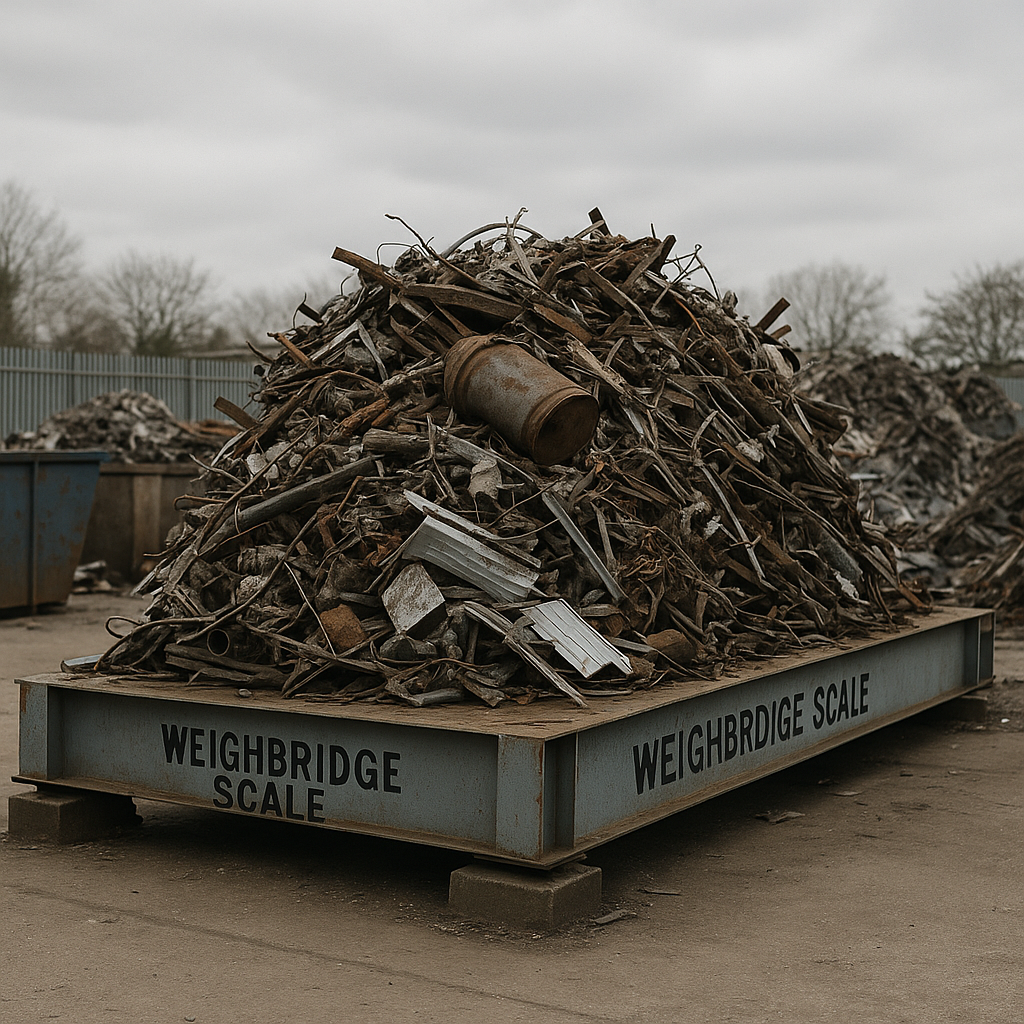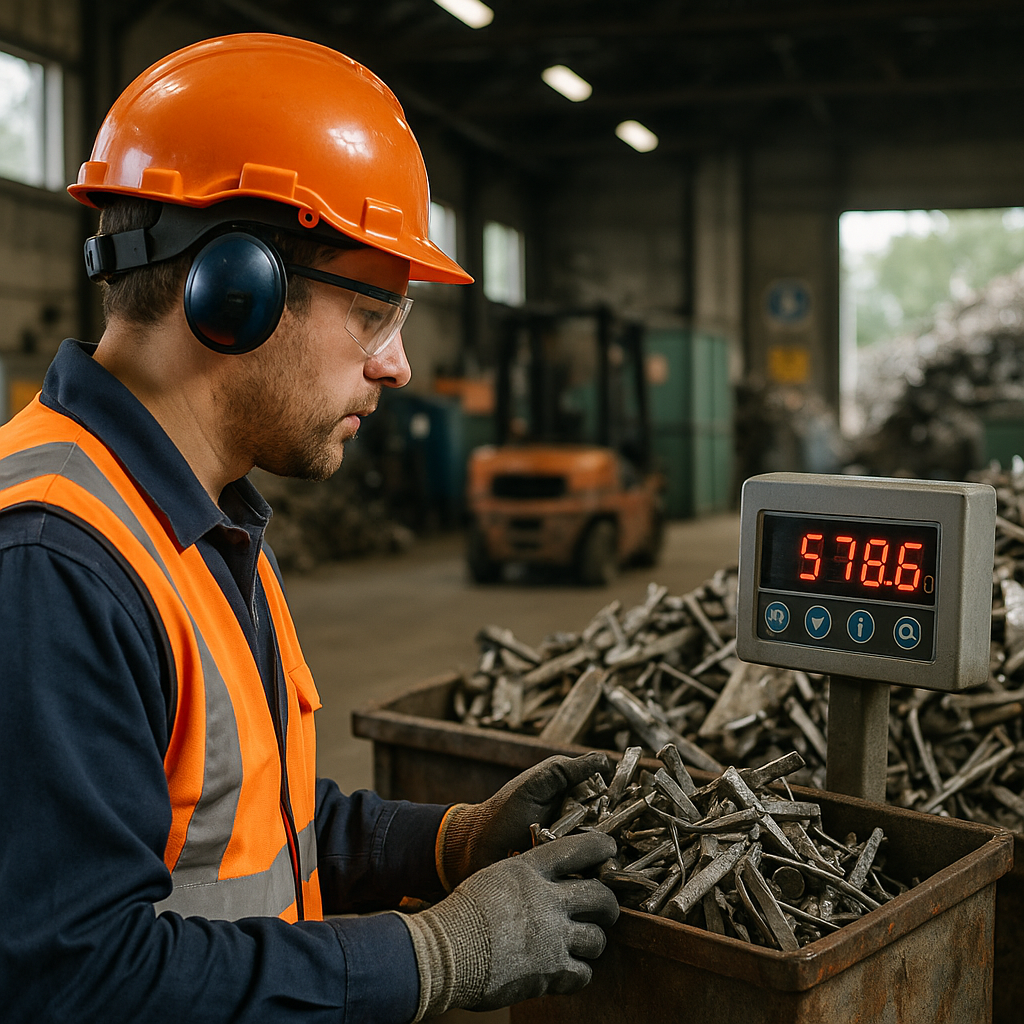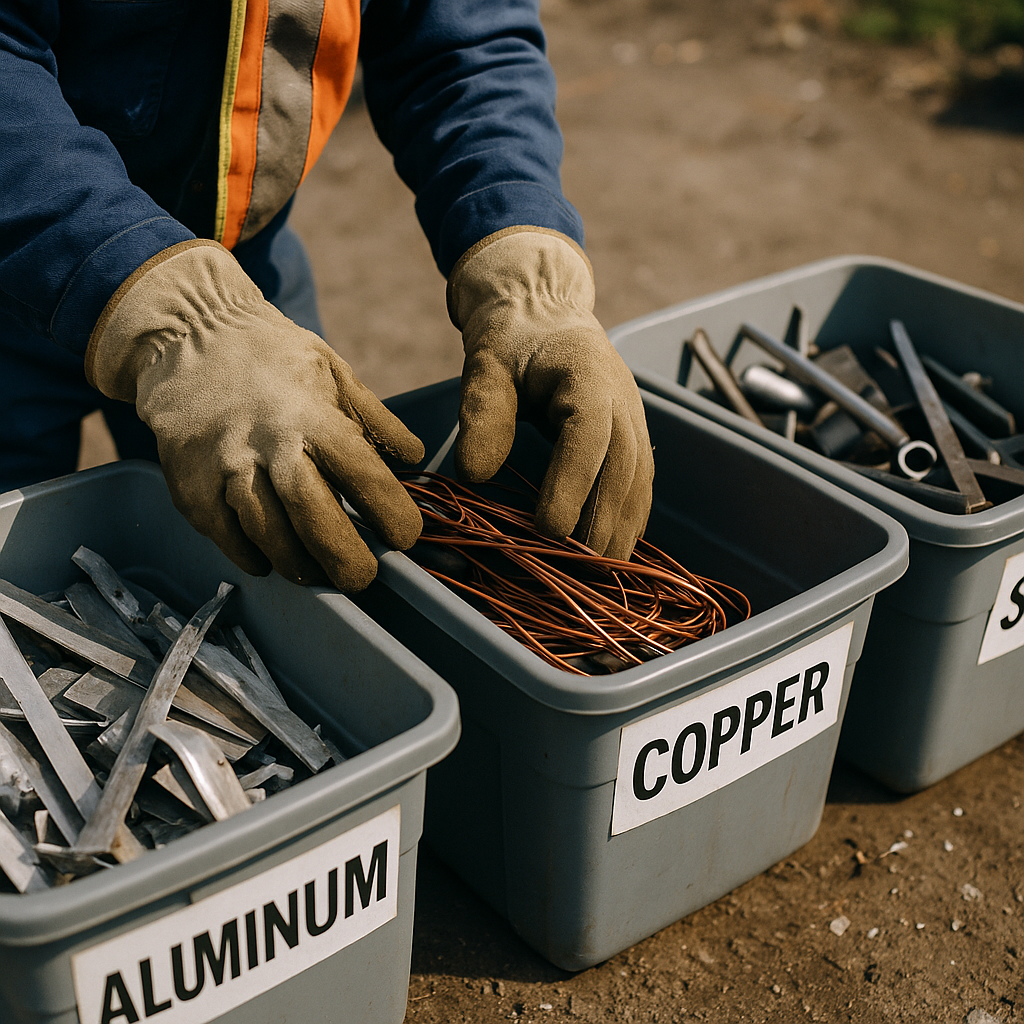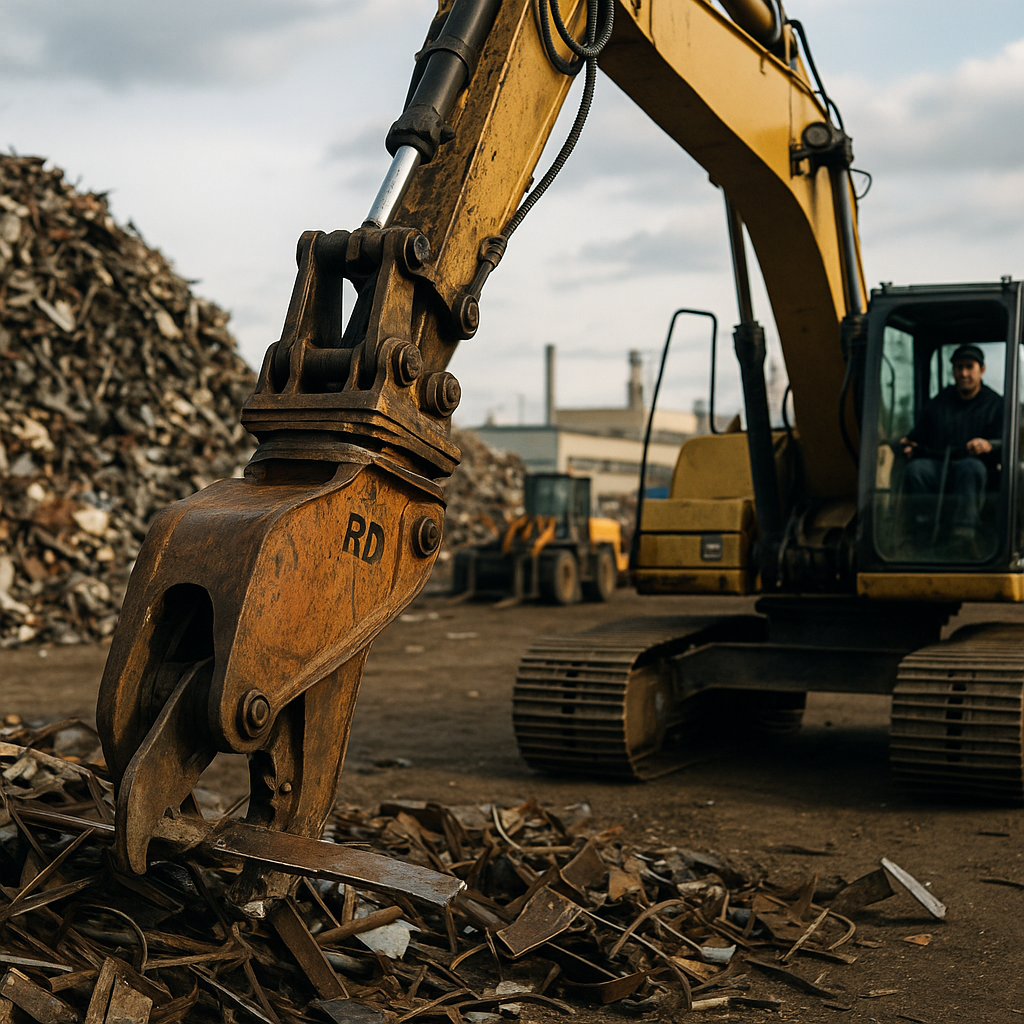5901 Botham Jean Blvd, Dallas, TX 75215
How Is Scrap Metal Weighed and Graded?
August 5, 2025In the recycling industry, accurate weighing and grading of scrap metal are crucial for fair transactions. Every pound of recycled metal contributes to environmental benefits and economic value. When materials are brought to a recycling facility, a systematic evaluation process determines exactly what has been brought and its worth.
Scrap metal recycling facilities use specialized equipment to weigh incoming materials precisely. The weight, combined with an expert assessment of metal type and quality, determines the final value of your scrap. This classification process ensures that high-quality materials receive appropriate compensation while maintaining the integrity of the recycling stream.
The grading system varies by metal type, with each category having specific criteria that affect its recyclability and market value. Factors such as purity, contamination levels, and overall condition play crucial roles in determining how scrap metal is classified. Understanding these fundamentals helps both individuals and businesses maximize the value of their recyclable metals.
What types of scales are used for weighing scrap metal?

Scrap yards rely on two main types of scales: truck scales and platform scales. Each serves a specific role in the recycling process and handles different load volumes.
Truck Scales
Truck scales are heavy-duty systems designed for very large loads. These industrial-grade scales can weigh entire vehicles loaded with scrap metal.
Truck scales are available in two configurations. Some are embedded in pits, making the weighing surface level with the ground for easy access. Others are above ground with ramps for vehicles to drive onto the platform.
The weighing process involves two measurements. First, the loaded vehicle is weighed. After unloading the scrap metal, the empty vehicle is weighed again. The difference between these weights determines the scrap material’s actual weight.
Platform Scales
Platform scales are smaller systems used for moderate quantities of scrap metal. They feature flat surfaces where pre-sorted materials can be directly placed.
Unlike truck scales, platform scales weigh only the material, not including the vehicle. This is ideal for processing smaller deliveries or weighing sorted materials within the facility.
Platform scales offer greater precision for smaller loads and occupy less space than truck scales. Many recycling facilities use them to weigh specific metal types after sorting.
Scale Specifications and Requirements
Both truck and platform scales must meet strict accuracy standards. Legal recycling operations need scales certified by state authorities. The National Conference on Weights and Measures issues annual NTEP Certificates to verify compliance with fair trade requirements.
The size, location, and capacity of these scales significantly vary between facilities. Large commercial recyclers might have multiple truck scales capable of weighing up to 80,000 pounds or more, while smaller operations might rely mainly on platform scales with lower capacities.
Modern scrap yard scales often feature digital displays and printing capabilities, producing tickets showing the material type, weight, and price per pound. This ensures transparent transactions and helps maintain accurate records.
| Scale Type | Truck Scales | Platform Scales |
| Load Capacity | Extremely large loads, up to 100,000 pounds | Smaller loads for modest quantities |
| Configuration | Embedded in pits or on ramps | Flat surfaces for direct placement |
| Weighing Process | Two measurements: Gross and Tare Weight | Gross Weight directly from the material |
| Usage | Weigh entire vehicles loaded with scrap metal | Weigh specific metal types after sorting |
Both scale types are essential in the recycling industry, ensuring accurate measurements that underpin fair transactions between recyclers and customers. The choice between truck and platform scales depends on the volume of materials processed, available space, and specific operational needs.
How is the actual weight of scrap metal determined?

The actual weight of scrap metal is determined by calculating the net weight, which is the true weight of the material after accounting for any containers or vehicles used for transport. The weighing method varies depending on the load size and the type of scale utilized.
Understanding Weight Terminology
Before examining the weighing process, it’s important to understand the three key weight measurements used in scrap metal recycling:
- Gross Weight: The total weight on the scale, including the scrap metal and any container or vehicle.
- Tare Weight: The weight of the empty container or vehicle without the scrap metal.
- Net Weight: The actual weight of just the scrap metal, calculated by subtracting the Tare Weight from the Gross Weight.
The formula is: Gross Weight – Tare Weight = Net Weight
Truck Scale Weighing Process
For large scrap metal loads delivered by truck, the weighing process typically involves these steps:
- The truck loaded with scrap metal drives onto the scale platform.
- An initial measurement is taken for the Gross Weight (truck + scrap metal).
- The truck proceeds to the unloading area where the scrap metal is removed.
- The empty truck returns to the scale to determine the Tare Weight.
- The difference between these two weights (Gross Weight – Tare Weight) gives the Net Weight of the scrap metal.
Truck scales are either built into a pit making them level with the ground or placed on the ground with ramps, allowing vehicles to drive onto the platform. These scales can typically handle weights up to 100,000 pounds, making them ideal for industrial-scale operations.
Platform Scale Weighing Process
For smaller scrap collections, platform scales are used following this process:
- Scrap materials are sorted by type (ferrous, non-ferrous, etc.).
- The empty container is weighed to determine its Tare Weight.
- The sorted scrap is placed in the container on the platform scale.
- The total weight (container + scrap) gives the Gross Weight.
- The Net Weight is calculated by subtracting the container’s Tare Weight from the Gross Weight.
Alternatively, if the scrap is placed directly on the scale without a container, the reading immediately provides the Net Weight.
Ensuring Accurate Measurements
Accuracy in weighing is crucial for fair compensation in the scrap metal industry. Important considerations include:
- Legal metal recycling facilities must use scales certified by the National Conference on Weights and Measures.
- Scales should receive an NTEP Certificate of Commerce annually to confirm they meet fair trade requirements.
- Modern scales with digital load cells offer more precise measurements than older analog systems.
- Recycling facilities should regularly calibrate their scales to maintain accuracy.
Understanding how scrap metal is weighed ensures transparency in the recycling process and fair compensation for materials. Whether delivering a truckload of industrial scrap or a small collection of household metals, the principles for determining net weight remain constant.
| Scale Type | Description | Load Type | Measurement Process |
|---|---|---|---|
| Truck Scale | Heavy-duty scales designed for large loads, capable of weighing entire vehicles. | Large loads including trucks | Two measurements: Gross Weight with load, then Tare Weight without load; difference gives Net Weight. |
| Platform Scale | Smaller scales for modest quantities, suitable for direct weighing on flat surfaces. | Smaller or pre-sorted materials | Material placed on scale to get Gross Weight; Tare Weight subtracted if containers are used. |
How are different types of scrap metal graded?

Scrap metal is first sorted into two main categories: ferrous (containing iron) and non-ferrous metals. This basic classification is fundamental to the metal grading system used in the recycling industry. Ferrous metals like steel and iron have iron as a major component, while non-ferrous metals such as aluminum, copper, and brass do not contain iron.
A simple magnetism test distinguishes these categories: a magnet adheres to ferrous metals but not to non-ferrous ones. This test is often the first step recyclers use to sort incoming materials.
Ferrous Metal Grading
Ferrous metals are graded based on several key factors. The Institute of Scrap Recycling Industry (ISRI) has developed standard specifications to classify ferrous scrap based on type, sizing, and metallic composition. Clean ferrous scrap must be free of dirt, non-ferrous metals, foreign materials, and excessive rust or corrosion.
Specifically, for steel scrap, recyclers assess the residual alloy content. Steel is deemed “free of alloys” when residual elements stay below certain thresholds: nickel (0.45%), chromium (0.20%), molybdenum (0.10%), and manganese (1.65%). The combined residuals other than manganese should not exceed 0.60 percent in total.
Ferrous metal grades also take into account the material’s thickness. Steel pieces thicker than 1/8 inch (approximately the size of a headphone jack) are classified as #1 or prepared steel, fetching higher prices than thinner material.
Non-Ferrous Metal Grading
Non-ferrous metals are generally more valuable than ferrous metals and undergo more detailed grading. For instance, copper is graded into several categories:
- Bare Bright Copper: The highest grade, consisting of clean, uncoated, and unalloyed copper wire
- No. 1 Copper: Clean, uncoated copper pipe or wire, free of solder or paint
- No. 2 Copper: Copper with minimal contamination such as solder, paint, or oil
Similarly, aluminum grades include clean aluminum (free of contaminants), painted aluminum (with a painted or coated surface), and dirty aluminum (with significant contamination from dirt, oil, or other metals).
Key Factors Affecting Metal Grades and Value
Several factors determine the grade and value of scrap metal:
Purity is a critical factor, with higher purity metals containing a greater percentage of the primary metal without contamination. Cleanliness also significantly impacts grading. The presence of contaminants like paint, oil, plastic, or foreign materials lowers both the grade and value of scrap metal.
The size and shape affect processing difficulty. Smaller or oddly shaped pieces may be more challenging to process, affecting their grade. Metals requiring minimal processing before recycling typically receive higher grades and better prices.
To improve scrap metal grades, recyclers often clean it to remove contaminants, separate different metal types, and strip insulation from wires to increase their value. Professional recyclers use X-ray fluorescence (XRF) or optical emission spectroscopy (OES) analysis to accurately determine the elemental composition of scrap samples.
| Characteristic | Ferrous Metals | Non-Ferrous Metals |
|---|---|---|
| Key Components | Iron | No Iron |
| Examples | Steel, Carbon Steel, Cast Iron | Aluminum, Copper, Brass |
| Magnetic Properties | Magnetic | Non-Magnetic |
| Corrosion Resistance | Lower corrosion resistance | Higher corrosion resistance |
| Common Uses | Construction, Automobiles, Industrial Containers | Aerospace, Canning, Electronics |
| Market Value | Generally lower | Generally higher |
| Recyclability | Most recycled metals globally | Retains properties after recycling |
Understanding the grading system helps recyclers maximize the value of scrap metals while ensuring they’re properly processed. By accurately identifying and grading metals, recycling facilities can more efficiently direct materials to the appropriate processing streams, ultimately conserving resources and reducing environmental impact.
What factors influence scrap metal pricing?
The scrap metal market is notably volatile, with prices capable of significant fluctuations within hours. Understanding the drivers of these changes helps both recycling businesses and customers effectively navigate this dynamic market.
Supply and Demand Dynamics
Scrap metal pricing, like most commodities, is influenced by fundamental economic principles. When demand exceeds supply, prices typically rise, whereas an abundance of scrap with limited demand causes prices to fall.
Various industries have a direct impact on these dynamics. The construction sector, for instance, consumes large amounts of recycled steel during building booms. Conversely, when construction activity slows, demand decreases, often leading to lower scrap steel prices.
The technology and manufacturing sectors similarly affect the demand for metals like copper and aluminum. When smartphone or vehicle production increases, so does the demand for these metals.
Seasonal Fluctuations
The time of year significantly influences scrap metal pricing. Spring and summer usually see higher prices as construction and manufacturing peak. Many recycling businesses report price increments of 10-15% during these warmer months.
In winter, prices often drop as construction projects slow and adverse weather conditions inhibit collection efforts. This seasonal trend presents opportunities for strategic timing in selling large quantities of scrap.
Quality and Processing Requirements
The condition of scrap metal directly impacts its value. Clean, sorted materials fetch premium prices because they require minimal processing. In contrast, corroded or mixed materials, or those containing contaminants, receive lower offers.
For instance, bare bright copper wire typically sells for nearly 20% more than copper wire with insulation due to the added cost of removing insulation.
Scrap yards often offer tiered pricing based on metal grade and purity, with #1 copper (99% pure) achieving higher prices than #2 copper (94-96% pure) due to reduced refining needs.
Energy and Production Costs
Energy is a significant factor in processing scrap metal. When fuel and electricity costs rise, recycling operations become more expensive, often lowering purchasing prices for scrap.
Transportation costs also affect pricing. Yards near ports or processing facilities generally offer higher prices due to reduced shipping expenses.
Global Economic Factors
International markets heavily influence scrap metal pricing. Countries with robust manufacturing sectors, particularly China and India, import large quantities of scrap metal. Changes in their economic conditions or import policies can drastically alter global prices.
Moreover, currency exchange rates play a role. A stronger dollar makes American scrap more expensive for international buyers, potentially reducing demand and lowering domestic prices.
Virgin Metal Market Comparison
Scrap metal prices often correlate with costs of newly mined (virgin) metals. When the cost of mining or refining virgin metals increases, recycled materials become more valuable. Conversely, reductions in virgin metal prices typically lead to lower scrap metal prices.
This relationship exists because many manufacturers weigh the cost-effectiveness of using virgin versus recycled materials.
| Factor | Impact on Pricing | Effects |
|---|---|---|
| Supply and Demand | High demand and low supply increase prices; abundant supply and low demand decrease prices. | Construction booms raise prices; slowdowns reduce them. |
| Seasonal Fluctuations | Prices are typically higher in spring and summer and lower in winter. | Peak construction and manufacturing activity raise prices; reduced activity in winter lowers them. |
| Quality and Processing Requirements | Clean, sorted metals command higher prices; contaminated or mixed metals are valued lower. | Clean scrap requires less processing, increasing its value. |
| Energy and Production Costs | Increased fuel and electricity costs lower buying prices due to higher recycling expenses. | Transportation costs affect price based on proximity. |
| Global Economic Factors | Strong international markets increase demand and prices; economic slowdowns decrease them. | Import policies and currency exchange rates also influence pricing. |
| Virgin Metal Market Comparison | Higher costs for mined metals increase recycled metal prices, and lower costs reduce them. | Manufacturers evaluate cost-effectiveness between virgin and recycled options. |
Price Volatility and Market Tracking
The complex interplay of these factors results in a market where prices can change rapidly. Industry professionals monitor commodity exchanges like the London Metal Exchange (LME) for general market direction, although actual scrap yard prices reflect local conditions and business costs.
Some scrap yards update their buying prices daily, while others adjust weekly based on market conditions. Businesses dealing in large volumes of scrap metal often develop relationships with recyclers to receive regular pricing information.
Conclusion: The importance of accurate weighing and grading in scrap metal recycling

Accurate weighing and grading of scrap metal are crucial to ensuring fair transactions in the recycling industry. Properly calibrated scales and correctly identified metals benefit both buyers and sellers through transparent, equitable exchanges. The scrap metal industry relies on trust, and precise measurements help maintain that foundation.
The grading system ensures recyclers receive appropriate compensation for various metal types and qualities, while buyers can process materials confidently per their specific requirements. Understanding these processes enables participants to make informed decisions, maximize returns, and contribute effectively to the circular economy. As environmental considerations increasingly influence metal recycling, awareness of weighing methods, grading systems, and market trends becomes more valuable for industry participants.
For reliable, transparent scrap metal recycling services that prioritize accurate weighing and fair grading, contact Okon Recycling at 214-717-4083.
